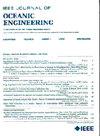海洋粗粒沉积物体积和结构参数演化研究技术
IF 5.3
2区 工程技术
Q1 ENGINEERING, CIVIL
引用次数: 0
摘要
本文详细介绍了一种测量粗粒度海洋沉积物体积和结构参数的新技术。该技术结合了用于沉积物跟踪的射频识别(RFID)技术和用于体积测量的三维扫描技术。该技术被应用于从所研究的海滩收集的真实海洋沉积物。在初步阶段,沉积物会使用低成本的3d扫描系统进行扫描,然后安装嵌入式RFID应答器,这样就可以对沉积物进行明确的识别。然后,鹅卵石被放置在海滩上,经过一段预定义的时间后,它们被定位并被用作探测器的专用RFID读取器检索。回收后,对鹅卵石进行三维扫描,以收集由水运动(主要是海浪)引起的颗粒间摩擦引起的磨损和碎裂过程导致的体积变化数据。该技术可以准确估计沉积物的形态变化,从而为沉积物稳定性提供重要的见解,并在更广泛的范围内,海岸侵蚀过程。此外,它允许研究一些纹理参数的演变,如球度或角度,可以从三维模型中提取。本文章由计算机程序翻译,如有差异,请以英文原文为准。
A Technique for the Study of the Volume and Textural Parameter Evolution of Marine Coarse Sediments
In this article, we detail a novel technique for measuring volume and textural parameters of coarse-grained marine sediments. The technique combines radio frequency identification (RFID) technology for sediment tracking with 3-D scanning for volume measurement. The technique is applied to real marine sediments collected from the beach under study. In the preliminary phase, the sediments are scanned using a low-cost 3-D scanning system and then fitted with an embedded RFID transponder, which allows their unambiguous identification. The pebbles are then deployed on the beach and, after a predefined period of time, they are located and retrieved by means of an ad-hoc RFID reader used as a detector. After retrieval, the pebbles are 3-D scanned to collect data on the volumetric changes that result from the abrasion and chipping processes caused by intergranular friction on their surfaces from water movements (mostly sea waves). The technique allows for an accurate estimation of morphological variations of sediments, thereby providing essential insights into sediment stability and, on a broader scale, coastal erosive processes. Moreover, it allows the study of the evolution of a number of textural parameters, such as sphericity or angularity, which can be extracted from the 3-D model.
求助全文
通过发布文献求助,成功后即可免费获取论文全文。
去求助
来源期刊

IEEE Journal of Oceanic Engineering
工程技术-工程:大洋
CiteScore
9.60
自引率
12.20%
发文量
86
审稿时长
12 months
期刊介绍:
The IEEE Journal of Oceanic Engineering (ISSN 0364-9059) is the online-only quarterly publication of the IEEE Oceanic Engineering Society (IEEE OES). The scope of the Journal is the field of interest of the IEEE OES, which encompasses all aspects of science, engineering, and technology that address research, development, and operations pertaining to all bodies of water. This includes the creation of new capabilities and technologies from concept design through prototypes, testing, and operational systems to sense, explore, understand, develop, use, and responsibly manage natural resources.
 求助内容:
求助内容: 应助结果提醒方式:
应助结果提醒方式:


